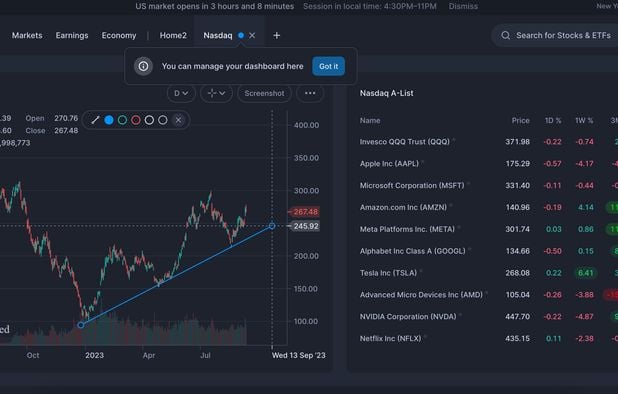It is crucial to evaluate the AI and Machine Learning (ML) models that are employed by stock and trading prediction systems. This will ensure that they provide accurate, reliable and actionable information. A poorly designed or overhyped model can result in financial losses and incorrect predictions. Here are 10 ways to evaluate the AI/ML platforms of these platforms.
1. Understanding the model's purpose and approach
Clarified objective: Determine the purpose of the model, whether it is for trading at short notice, investing in the long term, sentimental analysis, or a way to manage risk.
Algorithm Transparency: Verify if the platform is transparent about what kinds of algorithms they employ (e.g. regression, neural networks of decision trees and reinforcement-learning).
Customizability - Determine whether you can modify the model to meet your trading strategy and risk tolerance.
2. Evaluation of Performance Metrics for Models
Accuracy: Check the accuracy of the model when it comes to the prediction of future events. However, do not solely depend on this measurement because it could be misleading when used in conjunction with financial markets.
Precision and recall: Assess whether the model is able to identify true positives, e.g. correctly predicted price fluctuations.
Risk-adjusted returns: See whether a model's predictions result in profitable trades taking risk into account (e.g. Sharpe or Sortino ratio).
3. Check the model by Backtesting it
Backtesting the model by using historical data allows you to test its performance against prior market conditions.
Out-of-sample testing: Ensure the model is tested using data it was not developed on in order to prevent overfitting.
Scenario analysis: Assess the model's performance in various market conditions.
4. Be sure to check for any overfitting
Overfitting signals: Watch out models that do exceptionally well on data training, but not so well on data that isn't seen.
Regularization: Determine if the platform uses regularization techniques like L1/L2 or dropouts to prevent excessive fitting.
Cross-validation (cross-validation) Check that your platform uses cross-validation to assess the generalizability of the model.
5. Assessment Feature Engineering
Relevant Features: Look to see whether the model is based on meaningful characteristics. (e.g. volume, technical indicators, price as well as sentiment data).
Select features: Make sure the system only includes important statistically relevant features and does not include redundant or irrelevant information.
Dynamic updates of features Test to determine whether the model adjusts to the latest features or to changes in the market.
6. Evaluate Model Explainability
Interpretation: Make sure the model provides clear explanations for the model's predictions (e.g. SHAP values, importance of features).
Black-box model Beware of applications that use models that are too complicated (e.g. deep neural network) without describing the the tools.
User-friendly insights : Check whether the platform offers actionable data in a form that traders can use and be able to comprehend.
7. Reviewing the Model Adaptability
Market shifts: Find out whether the model can adjust to changing market conditions, like economic shifts, black swans, and other.
Check to see if your platform is updating its model regularly with the latest information. This will increase the performance.
Feedback loops. Make sure you include user feedback or actual outcomes into the model to improve.
8. Examine for Bias in the Elections
Data biases: Check that the data used in training are accurate and free of biases.
Model bias: Check if the platform actively monitors and corrects biases within the predictions of the model.
Fairness: Make sure the model does not disproportionately favor or disadvantage specific sectors, stocks or trading strategies.
9. Evaluate the efficiency of computation
Speed: Determine the speed of your model. to produce predictions in real time or with minimal delay particularly when it comes to high-frequency trading.
Scalability - Verify that the platform is able to handle large datasets, multiple users and still maintain performance.
Resource usage: Determine whether the model makes use of computational resources effectively.
10. Transparency and accountability
Model documentation: Ensure that the platform provides comprehensive documentation on the model's design, the process of training as well as its drawbacks.
Third-party audits : Confirm that your model was audited and validated independently by third-party auditors.
Error handling: Check if the platform has mechanisms to identify and correct model errors or failures.
Bonus Tips
Reviews of users and Case studies User reviews and Case Studies: Read user feedback and case studies in order to assess the performance in real-world conditions.
Trial period: Try the model free of charge to determine how accurate it is and how simple it is to utilize.
Customer support - Make sure that the platform has the capacity to provide a robust support service to help you resolve technical or model related issues.
With these suggestions by following these tips, you will be able to evaluate the AI and ML models on stock prediction platforms and ensure that they are trustworthy as well as transparent and in line to your goals in trading. Have a look at the top learn more here for site info including investing ai, ai investing, best ai for trading, ai stock market, ai stock picker, ai investing app, best ai for trading, ai stocks, best ai for trading, ai stock picker and more.

Top 10 Suggestions For Evaluating The Social And Community Features Of Ai Stock Trading Platforms
To know how users learn, interact, and share insights among themselves It is important to analyze the social and community features of AI trade and stock prediction platforms. These features can improve the user's experience as well as provide valuable assistance. Here are the 10 best tips for evaluating social and community features on these platforms.
1. Active User Group
Tips: Make sure the platform is active with a user base that is regularly engaged in discussion, shares information, and provides feedback.
Why? A community that is active indicates an ecosystem that allows users to develop and share knowledge from one another.
2. Discussion Forums and Boards
You can evaluate the quality of the quality of a message board by evaluating the amount of activity.
Why Forums are important: They allow members to talk about market trends as well as ask questions and discuss strategies.
3. Social Media Integration
Tips: Make sure the platform integrates with social media platforms for sharing information and updates (e.g. Twitter, LinkedIn).
The benefits of social media integration increase engagement and provide current market updates in real time.
4. User-Generated Content
Search for tools that allow you share and create content such as articles, blogs or trading strategies.
Why: User-generated content creates the spirit of collaboration and gives different perspectives.
5. Expert Contributions
Tip: See whether there are any contributions from experts in the field, like AI experts or market analysts.
The reason: Experts' opinions add credibility and depth to discussions in the community.
6. Real-time chat and messaging
Tips: Make sure that users can communicate with one another instantly using real-time chat or messaging.
What's the reason? Real-time interactions allow for rapid information exchange as well as collaborative work.
7. Community Moderation & Support
Tips: Determine the degree and kind of support that is offered by your community (e.g. Moderators or representatives for customer service).
The reason: Effective moderation creates a positive and respectful environment and support assists in resolving user issues promptly.
8. Events and Webinars
Tips - Find out if the platform offers live Q&A with experts as well as webinars and other events.
What's the point? These events provide an excellent opportunity to gain knowledge about the field and to have direct interaction with experts.
9. User Review and Feedback
TIP: Keep an eye out for features which allow users to give feedback or opinions about the platform and its features.
Why: User input helps determine strengths and areas to improve.
10. Gamification and Rewards
Tip. Make sure the platform offers gamification components (e.g., leaderboards and badges) and rewards for engaging in the game.
The reason: Gamification can encourage users to be more engaged with the community and platform.
Bonus Tip - Security and Privacy
Make sure that all community or other social features are backed by strong security and privacy measures to protect users' data and interactions.
By evaluating these factors and analyzing these variables, you can determine whether an AI-based stock forecasting and trading system offers a positive community that will improve the experience of trading. Take a look at the best ai copyright signals for website examples including stock predictor, ai stock prediction, stock trading ai, ai for trading stocks, ai options, best ai penny stocks, investing with ai, how to use ai for stock trading, ai in stock market, how to use ai for copyright trading and more.
